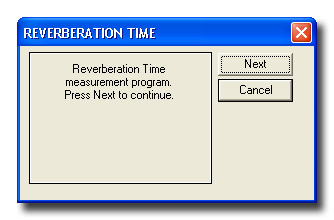
The reverberation time is the speed with which the sound ceases in the environment after the source has been turned off. This measurement is taken by calculating the time required for the sound level within an observation point to decay by 60 dB, starting from the moment the source was turned off.
Generally speaking, this measurement is not possible due to the insufficient signal/noise ratio of the source. Therefore the T20 and T30 estimations based on a decay respectively equal to 20dB and 30dB are calculated, starting from 5dB under the noise source maximum level.
For the reverberation time to have a meaning according to ISO norm, it is necessary that
the reference parameters were T20 or T30
the linear decay correlation coefficient were at least 0.95
the difference between signal level and background noise were at least 35 dB for T20 and 45 dB for T30
To perform the measurements, enable the average reverberation time calculation on the sound level meter.
The Delta Ohm HD2110 and HD2010 sound level meters perform the reverberation time measurement through an additional software module: please see the tools manual for the details.
The reverberation time calculation uses two analysis methods: the interruption of the sound source and the integrated impulse response. Both methods are supported by the sound level meters and NoiseStudio software.
The sound level meter measurement is performed in two different phases: in the first phase, 2 second long, the background noise level is acquired while in the second phase the environment noise decay, after the source interruption or the generated impulse, is analysed.
The parameters calculation is carried out in parallel for both wide band channels A, C and Z and for octave bands from 125 Hz to 8 kHz and third of an octave from 100 Hz to 10 kHz. The sound level is integrated linearly 32 times per second without interruptions, simultaneously on all measurement bands.
The definition of the reverberation time measurement would require the analysis of a decay equal to 60 dB. Generally, this is not possible due to the insufficient signal/noise ratio of the source. The reverberation time is therefore estimated starting from the measurement of the decay time over a limited stretch equal to 30 dB, starting from 5 dB under the stationary level (T60(30) or T30). In practice a linear interpolation is carried out using the least squares method on the decay stretch that starts from the point under 5 dB compared to the stationary level and terminates 35 dB under this level.
In case of an insufficient signal/noise ratio, the estimation of the reverberation time based on a decay of 20 dB, again starting from 5 dB under the stationary level (T60(20) or T20) is also allowed. The gradient of the line gives the decay rate in dB/s from which the reverberation time can be extrapolated.
In addition to calculating the reverberation time T30 or T20 it is necessary to analyse the decay curve visually to check the possible presence of anomalies in the decay and also for possible double gradients. It needs to be remembered that if the linear correlation coefficient calculated on the interpolated stretch is lower than 0.95 it is not possible (according to ISO 3382) to consider the measurement valid and therefore the reverberation time cannot be defined.
The NoiseStudio software has a wizard for reverberation time measurement: this procedure is started by selecting Options >> Reverberation Time.

Press NEXT to continue and select the type of measurement: interrupted noise source or integrated impulse response method.

Interrupted noise source method
Set up the system for the generation of the noise: properly amplified, the PC sound card output can be used as source. So the noise emitted can be controlled directly using the PC.
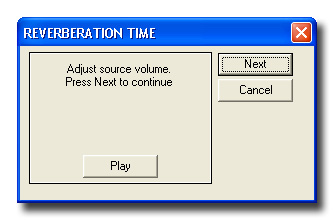
Press PLAY to start the sound card control software: adjust the volume as appropriate. If a standalone noise source is used, adjust its volume now.
Turn off the source and press NEXT to continue: the program for reverberation time measurement is loaded in the sound level meter.

Once loaded, pressing NEXT sets the instrument for background noise measurement:
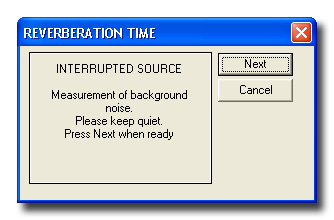
Press NEXT when ready: during this phase, avoid any foreign noise that could affect the measurement.
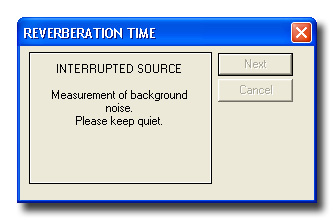
When the background noise measurement is complete, turn on the noise source:

... and, when "Turn off the sound source..." appears, turn it of within 5 seconds:
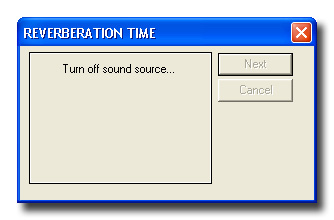
The sound level meter measures the environment noise decay: during this phase (about 6 seconds), avoid undesired noises that could affect the measurement. The logged data processing follows:
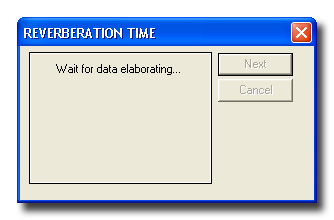
At the end, press NEXT to download the processed data to the PC:
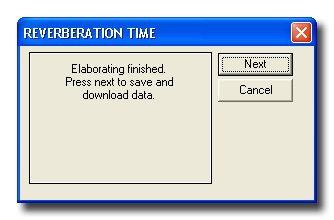
After checking the measurement is correct, you can proceed with the following analysis (NEXT) or end off (CANCEL).
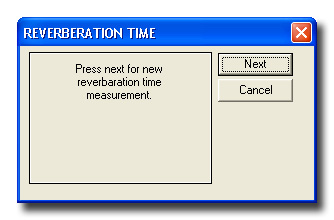
Integrated impulse response method
Set up the system for the generation of the noise: after selecting the integrated impulse response method, the program for reverberation time measurement is loaded in the sound level meter:

By pressing NEXT, the instrument is set for background noise measurement:
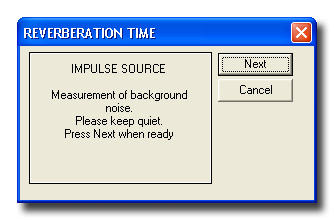
Press NEXT when ready: during this phase, avoid any foreign noise that could affect the measurement.

You are now prompted to activate the impulsive source: perform this operation within 5 seconds.

The sound level meter measures the environment noise decay: during this phase (about 6 seconds), avoid undesired noises that could affect the measurement. The logged data processing follows:

At the end, press NEXT to download the processed data to the PC:

After checking the measurement is correct, you can proceed with the following analysis (NEXT) or end off (CANCEL).

If the measurement was not carried out correctly, the following error message appears:
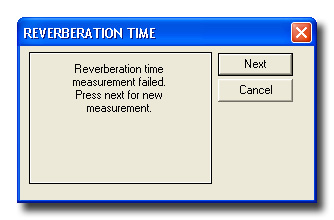
Press NEXT to continue or Cancel to exit.
The measurements reports downloaded from the sound level meter and concerning the reverberation time are highlighted in the Section List by the title REVERBERATION:

Per each session, the reverberation times are reported by octave from 125Hz to 8kHz (-Octave) and by third of octave from 100Hz to 10kHz (-TOctave).
In the following picture you can see the results of the reverberation time analysis, e.g. the results by third of octave. Some table items can be replaced by dashes (--) to indicate that in those points the dynamic is not sufficient to give a correct value.
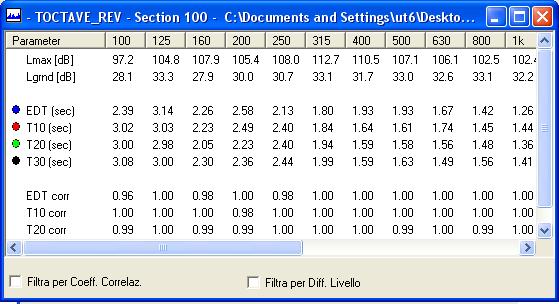
The screen page will display:
Lmax (dB): Captured Noise Maximum Level
Lground (dB): Background Noise Level
EDT (sec): Early Decay Time calculated on the first 10 dB decay, starting from the maximum level and expressed in seconds
T(10), T(20) and T(30) (sec) reverberation times calculated on a 10, 20 and 30 dB decay, starting from 5 dB under the measured maximum.
EDT corr, T10 corr, T20 corr and T30 corr are the correlation coefficients resulting from the linear interpolation applied to the decay curves.
The reverberation time results are also displayed graphically by selecting "View >> Graph".
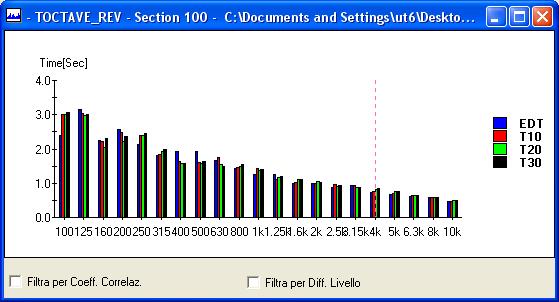
The data and relevant graphs can be filtered so as to exclude the results that do not conform with the various regulations requirements. For example, according to the ISO3382 norm, the reverberation times resulting from the calculation of a linear correlation coefficient below 0.95 should be discarded.
In order to apply this filter to the graph and exclude the non-conforming results, press "Filter by Correl. Coeff." and input the value 0.95. The reverberation results will be updated by removing the elements excluded by the filter. The data with a coefficient lesser than or equal to 0.95 are replaced by X and the graph elements become invisible.
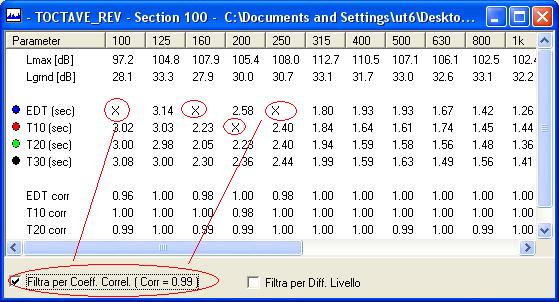
The "Filter by AMPLITUDE level" works similarly, intervening on the difference between Lmax and Lground. Again, according to ISO 3382 the signal/noise ratio must respectively be at least 45 dB and 35 dB for the T30 and T20 measurements. To exclude the results from noise levels outside the norms, input the filter value: as in the previous case, the values outside the filter characteristics, are excluded.
You can display the sound decay time trend by selecting the "Tool -> Reverberation Decay" menu item.

The reverberation time can be estimated directly on the decay curves by using the markers. The label T(B-A) shows the calculated reverberation time by comparing the selected decay to the 60 dB required by the definition.
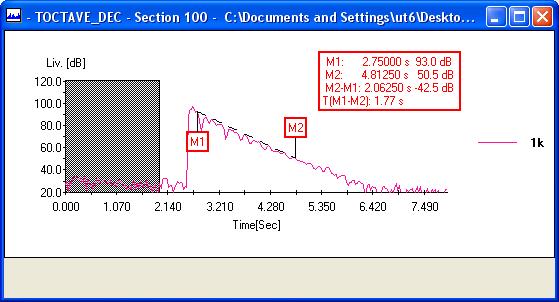
The Schroeder's Integral (Tool -> Schroeder Integral) is a technique that allows, starting from the measurement of the environment response to the sound impulse, to obtain the same sound level decay curve that would have been measured by the stationary noise technique. The calculation is performed automatically by the software: you will get a "clean" and "ripple-free" decay curve on which the markers function can be applied more easily so as to calculate the reverberation time.
In the following screen you can see a curve before and after applying the Schroeder's Integral. As you can see, the "ripples" are reduced in the second curve.
